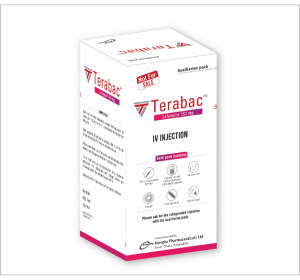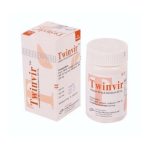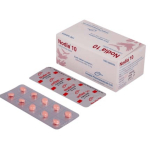Terabac(Lefamulin Injection)

Therapeutic Group: Anti Bacterial
Presentation
TerabacTM Injection: Each vial contains Lefamulin acetate INN equivalent to Lefamulin 150 mg in 15 mL concentrate for solution for infusion.
Description
Lefamulin is a semi-synthetic pleuromutilin antibacterial agent for oral and intravenous administration. It inhibits bacterial protein synthesis by binding to the peptidyl transferase
center of the 50S bacterial ribosome. Lefamulin is bactericidal in vitro against S. Pneumoniae, H. Influenzae, and M. Pneumoniae (including macrolide-resistant strains) and bacteriostatic against S. Aureus and S. Pyogenes at clinically relevant concentrations.
Indications
Lefamulin is indicated for the treatment of adults with community-acquired bacterial
pneumonia (CABP) caused by the following susceptible microorganisms: Streptococcus pneumoniae, Staphylococcus aureus (methicillin-susceptible isolates), Haemophilus influenzae, Legionella pneumophila, Mycoplasma pneumoniae, and Chlamydophila pneumoniae.
Dosage & Administration
150 mg every 12 hours by intravenous infusion over 60 minutes for 5-7 days. Patients with Hepatic Impairment: Reduce the dosage of LEFAMULIN Injection to 150 mg infused over 60 minutes every 24 hours in patients with severe hepatic impairment (Child-Pugh Class C).
Preparation of Lefamulin Injection for Intravenous Infusion
• Dilute the entire 15 mL vial of Lefamulin Injection into the diluent supplied with Lefamulin injection containing 250 mL of 10 mM citrate buffered 0.9% sodium chloride.
Use aseptic technique when adding Lefamulin Injection into the diluent and mix thoroughly.
• Before administration, parenteral drug products should be inspected visually for particulate matter and discoloration. Use the diluent bag only if the solution is clear and the container is undamaged. Do not use the diluent bag in series connections.
• Do not add other additives to the diluent bag because their compatibility with Lefamulin injection has not been established.
Side Effects
The most common adverse reactions (incidence ≥2%) are: administration site reactions, hepatic enzyme elevation, nausea, hypokalemia, insomnia, headache, diarrhea, and vomiting.
Adverse reactions occurring in less than 2% of patients are: anemia, thrombocytopenia, atrial fibrillation, palpitations, abdominal pain, constipation, dyspepsia, epigastric
discomfort, erosive gastritis, Clostridium difficile colitis, oropharyngeal candidiasis, vulvovaginal candidiasis, increased alkaline phosphatase, increased creatine phosphokinase, electrocardiogram QT prolonged, increased gamma-glutamyl
transferase, somnolence, anxiety, urinary retention.
Precautions
QT Prolongation:
Lefamulin has the potential to prolong the QT interval of the electrocardiogram (ECG) in some patients. Avoid Lefamulin use in the following patients:
• Patients with known prolongation of the QT interval
• Patients with ventricular arrhythmias, including torsades de pointes
• Patients receiving Class IA (for example, quinidine, procainamide) or Class III (for example, amiodarone, sotalol) antiarrhythmic agents.
• Patients receiving other drugs that prolong the QT interval, such as antipsychotics, erythromycin, pimozide, moxifloxacin, and tricyclic antidepressants In patients with renal failure who require dialysis, metabolic disturbances associated with renal failure may lead to QT prolongation. In patients with mild, moderate, or severe hepatic impairment, metabolic disturbances
associated with hepatic impairment may lead to QT prolongation. If used with Lefamulin cannot be avoided in specific populations predisposed to QT prolongation or those receiving another drug that prolongs the QT interval, ECG monitoring is recommended during treatment. The magnitude of QT prolongation may increase with increasing concentrations of
Lefamulin or increasing the infusion rate of intravenous formulation. Therefore, the recommended dose and infusion rate should not be exceeded.
Embryo-Fetal Toxicity:
It may cause fetal harm. Advise females of reproductive potential of the potential risk to the fetus and use effective contraception.
Use in Pregnancy & Lactation
Pregnancy:
Based on findings from animal studies, Lefamulin may cause fetal harm when administered to pregnant women. There are no available data on the use of Lefamulin in pregnant women.
Lactation:
Lefamulin may excrete in human milk. Because of the potential for serious adverse reactions, including QT prolongation, a woman should pump and discard human milk for the duration of treatment with Lefamulin and for 2 days after the final dose.
Drug Interaction
Avoid concomitant use of Lefamulin Injection and Lefamulin Tablets with strong and moderate CYP3A4 inducers and inhibitors or P-gp inducers and inhibitors unless the benefit outweighs the risks (for example, alprazolam, diltiazem, verapamil, simvastatin, vardenafil).
Avoid concomitant use of Lefamulin Injection and Lefamulin Tablets with drugs that effect cardiac conduction (for example, Class IA and III antiarrhythmics, antipsychotics, erythromycin, moxifloxacin, tricyclic antidepressants).
Over Dose
Treatment of overdose with Lefamulin should consist of observation and general support measures. Lefamulin and its primary metabolite are not dialyzable.
Storage
For Terabac Injection: Store at 2°C to 8°C in a refrigerator. Do not freeze. Keep away from light and out of the reach of children.
For auxiliaries pack: Do not store above 30°C. Keep away from light and out of the reach of children.
Commercial Pack
TerabacTM Injection: Each box contains one vial containing Lefamulin 150 mg. The auxiliaries box contains one bottle of 250 ml 10 mM citrate buffered 0.9% Sodium Chloride, one sterile disposable syringe (20 ml), one infusion set with a butterfly needle, a hanger, a first aid band and an alcohol pad.



